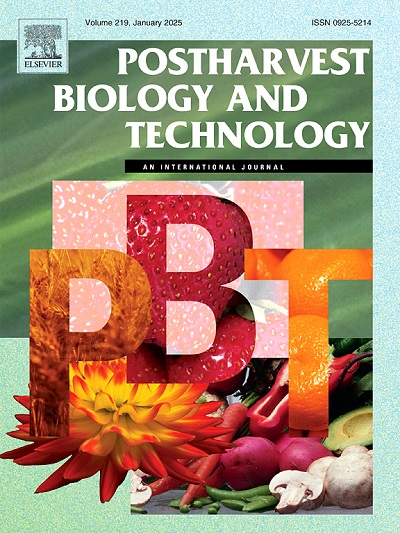Apyrase MaAPY2 regulates the chilling tolerance of banana fruit as a negative modulator
IF 6.8
1区 农林科学
Q1 AGRONOMY
引用次数: 0
Abstract
Chilling injury (CI) affects greatly postharvest quality of banana fruit during storage at < 13 °C. Apyrases (APYs) as a class of nucleoside triphosphate diphosphohydrolases (NTPDases) play a crucial role in regulating energy levels under various stress conditions. The potential effects of MaAPY2 on CI in banana fruit stored for 6 d at 6 °C involved in the regulation of antioxidant ability and energy status were investigated. Ultrastructural observation revealed more severe mitochondrial structures in the transient overexpressed MaAPY2 (OE-MaAPY2) fruit. Furthermore, enhanced generation of reactive oxygen species, in association with the accelerated CI symptoms in the OE-MaAPY2 fruit under cold stress condition was observed, with low activities of antioxidant enzymes, including superoxide dismutase, catalase, and peroxidase, accompanied by a high activity of polyphenol oxidase. Transcriptomic analysis was performed to uncover the variations of transcriptional levels in banana fruit during CI development. Overall, these results implied that MaAPY2 to serve as a negative modulator could reinforce CI symptom in banana fruit by triggering oxidative stress and damaging mitochondrial integrity, which provided new insights on the regulatory CI mechanism of banana fruit during low-temperature storage.
Apyrase MaAPY2作为负调制剂调控香蕉果实的抗寒性
低温伤害(CI)对香蕉果实采后品质的影响较大。Apyrases (APYs)是一类核苷三磷酸二磷酸水解酶(ntpases),在调节各种应激条件下的能量水平方面起着重要作用。研究了MaAPY2对香蕉果实6℃贮藏6 d后CI的潜在影响,包括对香蕉果实抗氧化能力和能量状态的调节。超微结构观察显示瞬时过表达MaAPY2 (OE-MaAPY2)的果实线粒体结构更为严重。此外,在冷胁迫条件下,OE-MaAPY2果实活性氧生成增强,CI症状加速,抗氧化酶(包括超氧化物歧化酶、过氧化氢酶和过氧化物酶)活性降低,多酚氧化酶活性较高。转录组学分析揭示了香蕉果实在CI发育过程中转录水平的变化。综上所述,这些结果提示MaAPY2作为负调节因子可通过触发氧化应激和破坏线粒体完整性等方式强化香蕉果实CI症状,为香蕉果实低温贮藏过程中CI的调控机制提供了新的认识。
本文章由计算机程序翻译,如有差异,请以英文原文为准。
求助全文
约1分钟内获得全文
求助全文
来源期刊

Postharvest Biology and Technology
农林科学-农艺学
CiteScore
12.00
自引率
11.40%
发文量
309
审稿时长
38 days
期刊介绍:
The journal is devoted exclusively to the publication of original papers, review articles and frontiers articles on biological and technological postharvest research. This includes the areas of postharvest storage, treatments and underpinning mechanisms, quality evaluation, packaging, handling and distribution of fresh horticultural crops including fruit, vegetables, flowers and nuts, but excluding grains, seeds and forages.
Papers reporting novel insights from fundamental and interdisciplinary research will be particularly encouraged. These disciplines include systems biology, bioinformatics, entomology, plant physiology, plant pathology, (bio)chemistry, engineering, modelling, and technologies for nondestructive testing.
Manuscripts on fresh food crops that will be further processed after postharvest storage, or on food processes beyond refrigeration, packaging and minimal processing will not be considered.
 求助内容:
求助内容: 应助结果提醒方式:
应助结果提醒方式:


